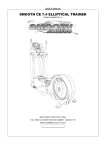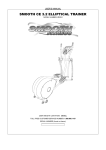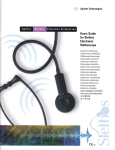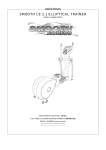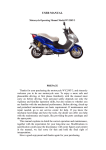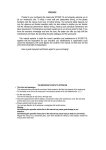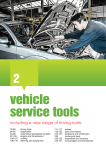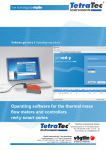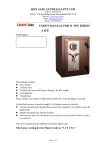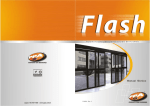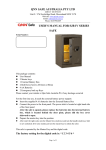Download NCT-1500 Common Rail Tester Quick Manual
Transcript
NCT-1500 Common Rail Tester Quick Manual 1. GENERAL This Tester has been developed to diagnose efficiently and accurately for diesel vehicles with common rail system. 1-1. Criteria of diagnosis using Common Rail Tester Impossible to start engine or engine stall while driving ※ It would be recommended performing Power Balance Test by Scanners(for Bosch system) or by disconnecting injector's connecter one by one(for Delphi system), if vehicle has problem beside the above symptoms such as engine vibration or emission of black/white smoke while engine idle. The problem may be due to differences of the injected amount in each injector. 1-2. Notice A CRDi system has been constructed using precision-made components. If an extremely small foreign particle enters the system during service, it may cause sticking or clogging of injectors. Therefore, be sure to eliminate any dust or contaminated deposits on or around the engine and fuel lines during service. 2. COMPONENTS 1 16 9 2 3 18 10 11 M12mm 4 M14mm 5 20 12 13 6 21 22 7 15 8 14 23 17 17 19 1. Tool Case 2. Plug (for Delphi) 3. Plug (for Bosch) 4. Flask & Holder 5. Injector return hose adapter 6. Injector return hose plug 7. Flushing Tube 8. Dust Cap 9. High pressure gauge set 10. Adapter connector (for Delphi old) 11. Adapter connector (for Delphi new) 12. Adapter connector (for Bosch) 13. Vacuum Gauge 14. Low pressure gauge 15. Gauge connection tube 16. Connection Adapter 17. Connection adapter with hose 18. Fuel Filter Plug 19. Dummy Resister 20. Dummy Injector 21. Compression Gauge 22. Block Tube 23. User's Manual 1 1. LOW PRESSURE TEST 3. DIAGNOSTIC 4-1. DIAGNOSIS PROCEDURE ACCORDING TO SYMPTOM 1) When the engine is not able to start ① Low Pressure Line Test → ② Injector Back Leak Test (Static Test) → ③ High Pressure Line Test 2) When the engine is able to start ① Low Pressure Line Test → ② Injector Back Leak Test (Dynamic Test) → ③ High Pressure Line Test 4-2. LOW PRESSURE FUEL LINE TEST 1) Remove fuel hose from fuel filter and connect low pressure gauge (NCT-1051) or vacuum gauge (NCT-1050) according to engine system as shown. * Additional parts needed: tube for gauge connection (NCT-1052), Connection adapter with hose (NCT-1054), connection adapter (NCT-1053) Fuel Filter Plug (NCT-1055) 2) Start the engine and keep idle approximately 5seconds, then turn of the engine. Internal suction pump type (Bosch Type Ⅰ) (A engine / U engine) Vacuum Gauge ⓑ ⓑ Vacuum Gauge ⓒ Test Tube Assay ⓓ Connection Adapter ⓓ ⓒ ⓑ ⓓ ⓒ Internal suction pump type (Bosch Type) CASE VACUUM JUDGMENT 1 10~20 cmHg System normal (good condition) 2 20~60 cmHg Filter or fuel line clogging (pump in good condition) 3 0~10 cmHg Air leak in to the system or Suction pump damage 2 1. LOW PRESSURE TEST Electric pump type (Bosch Type II) Electric pump type (BOSCH Type Ⅱ) Pressure Gauge ⓐ ⓒ ⓓ ⓔ ⓕ ⓐ Low Pressure Gauge Test Tube Assay Connection Adapter Connection Adapter with Hose Hose Clamp EURO-Ⅲ model CA SE ⓔ ⓒ ⓓ ⓕ PRESSURE (bar) JUDGMENT 1 1.5~3.5 kg/㎠ System normal 2 0 ~1.5 kg/㎠ Fuel Filter (or fuel line / strainer) clogging 3 no pressure Abnormal function of fuel pump EURO-Ⅳ model CA SE Fuel pump (Electric) PRESSURE (bar) JUDGMENT 1 2.5 ~ 5 kg/㎠ System normal 2 0.5~2.0 kg/㎠ Filter or fuel line clogging (pump in good condition) 3 no pressure Abnormal function of fuel pump Internal suction pump type (Delphi) ⓑ ⓒ ⓓⓓ ⓖ ⓖ Internal suction pump type ( Delphi) CASE VACUUM JUDGMENT 1 10~20 cmHg System normal (good condition) 2 20~60 cmHg Filter or fuel line clogging (pump in good condition) 3 0~10 cmHg Air leak in to the system or Suction pump damage 3 1. LOW PRESSURE TEST 4-3. INJECTOR BACK LEAK TEST (STATIC) 1) Remove the return hose from each injector and Install injector return hose adapter visible tubes and connect the visible tube's end to the flasks 2) Disconnect "A" point on the fuel return hose in below photograph and block the fuel return hose in the direction of the high pressure pump with injector return hose plug 3) Connect the adapter connector to rail pressure sensor and connect high pressure gauge as shown. 4) Disconnect the injector connectors to prevent its operating. Delphi, Bosch TypeⅠ 5) for “ A” engine Remove the Inlet Metering Valve connector to allow fuel feeding to high pressure line. Bosch Type Ⅱ 6) Disconnect the Pressure Control Valve connector and connect the power line on High Pressure Gauge to the Pressure Regulator Valve, and then connect High Pressure Gauge 's lead to battery so that pressure control valve will block fuel return from rail. 7) Crank the engine once for 5~6 seconds ※ Cranking engine about 10second build pressure, test again if pressure are not reach to maximum pressure. ※ Cranking RPM must exceed 200 RPM. ※ Perform the test under 30℃ with coolant temperature (If the fuel pressure test performed over30℃, the fuel pressure indicated may be different according to fuel viscosity change.). 8) Read the pressure from high pressure gauge and measure the amount of fuel contained at each visible tube 9) Judgment Injector Back Leak CASE PRESSRUE BACK LEAK JUDGEMENT 1 1000~1800 (above 1000) 0~200mm (below 200) Normal 2 0~1000 (below 1000) 200~400 (above 200) Faulty injector (excessive back leak) 3 0~1000 (below 1000) 0~200 (below 200) HP Pump (Insufficient pressure) SERVICE SPEC High pressure : Above 700 bar ( with normal Back Leak condition) ※ Exceeding back leak can cause insufficient high pressure Back Leak : Less than 3.5 times than minimum amount injector CHECK POINT (if test is failed ) - Fuel Leak (rail plug or pipes connection) - PRV (leakage or damaged) - Fuel line ( clogging filter ) - HP pump (leakage or damaged) 4 3 2 1 Adapters for rail pressure sensor High pressure sensor Dummy Resister Sensor abnormal Low pressure Normal High pressure Pump 4 2.INJECTOR BACK LEAK TEST (DYNAMIC) 4- 4. INJECTOR BACK LEAK TEST (DYNAMIC) 1) Remove the return hose from each injector and Install injector return hose adapter (NCT-1032), visible tubes (NCT-1032), flasks (NCT-1030) and injector return hose plug (NCT-1033) referring to Injector back leak test (STATIC) in previous page. 2) Conduct the high pressure leak test referring to following explanation. BOSCH Type Ⅰ,Ⅱ,Ⅲ : D3EA(1.5D-ENG), D4EA(2.0D-ENG), D4FA(U-ENG), D4CB(2.5A-ENG) 3) Start engine → 3 minutes at idle → accelerate engine up to 2500 rpm and keep the 2500rpm for 2 minutes →Stop Engine after 2 minutes 4) When the test is completed, measure the amount of fuel in each flask (NCT-1030). 5) Judgments 30sec / 3000rpm Start 1min stop BOSCH Type Ⅰ,Ⅱ,Ⅲ Replace the injector which is shown more 3 times than the minimum value. #2 Injector abnormal Normal condition Start 2min Stop Idle acceleration 1 2 3 1 4 2 3 4 DELPHI : J3 (2.9L) 3) Connect the Hi-Scan and select the 'High Pressure Leak Test' mode. 4) Conduct the 'High Pressure Leak Test' untill the Hi-Scan finish the test automatically. or manualy : Start engine → 2minutes at idle → 3 times acceleration →Stop Engine 5) For the accuracy of the test, perform the test more than twice and select the largest amount as a measured value. ※ The flasks (NCT-1030) should be empty before the 2nd test started. 6) Judgments DELPHI Replace the injector which indicates exceeds 25cc. Service Limit 25cc 1 2 3 4 Abnormal injector 5 3. HIGH PRESSURE TEST 4-5. HIGH PRESSURE PUMP TEST Purpose of the test : Inspection for mechanical capability of the High pressure pump (Maximum pressure check) Method : Check the pumping capability of the high pressure pump by actuating pump after blocking rail's outlets using the plug and regulator. Plug : Blocking the rail circuit Regulator Valve : Preventing over pressure of high pressure line BOSCH System Rail Plug 1) Clean the regulator valve, regulator valve adaptor and plugs with diesel fuel. 2) Remove all 4 fuel injector pipes from the common rail and disconnect the rail pressure sensor's connector. High pressure sensor Dummy Resister 3) Install the regulator valve, plugs dust caps adapter connector and High pressure gauge to the common rail securely as shown. ※ Be sure that the regulator valve and the plugs (NCT-1020 or NCT-1021) have installed securely so that there will not be any fuel leakage. Delphi, Bosch TypeⅠ(A engine U engine) 4) Disconnect Pressure Control Valve connector and connect the PRV connector and battery lead wire to the battery for the test. And then turn on the power switch so that pressure control valve will block fuel return from rail. 5) Crank the engine for 5-6 seconds. For the accuracy of the test, perform the test twice and select the higher pressure one as a measured value. 6) Judgment If the fuel pressure indicated on the gauge is within the range of specification, the high pressure pump is normal. But if not check the below items before the High pressure pump replaced. High pressure Pump DELPHI System NOTE : The buzzer will be ringing and changed the color of bulb after 5minuts of each test for the safety reasons ( to prevent over heating and battery discharged ) - 0~5 minutes : Maximum currant supply to the PRV - 5 or over : Low (regulated) currant are supply to the PRV (buzzer ringing) Pressure Valve Connector High pressure Pump Current ON Off High pressure sensor 0 5 10 Minute 6 3. HIGH PRESSURE TEST 4-5. HIGH PRESSURE PUMP TEST b. If fuel pressure is lower than specification, test it again when coolant temperature is below 30℃. The pump is in normal condition if the pressure restores to normal range. c. In case of the system in which pressure control valve implemented, check the valve condition & internal leak and replace them if necessary. * Refer to '4-6 pressure control valve test' procedure If fuel pressure indicated on the gauge is lower than specification there may be a problem in the rail pressure sensor or its circuit even fuel flows out from the regulator valve (NCT-1020) Specification of high pressure of common rail : BOSCH System : 1000~1500 bars DELPHI System : 1050~1600 bars 7 4. PRESSURE CONTROL VALVE TEST 4-6. PRESSURE CONTROL VALVE TEST 1) Remove fuel return connector from PCV upper. 2) Remove fuel return hose from PCV lower. 3) Disconnect Pressure Control Valve connector and connect the High Pressure Gauge(NCT-1040) to the Pressure Control Valve, and then connect the High Pressure Gauge(NCT-1040)'s lead to battery so that pressure control valve will block fuel return from rail. 4) Put fuel return pipes to flasks(NCT-1030). 5) Crank the engine for 5 seconds. 6) Check fuel return amount. ※ Service Limit : Less than 10cc/ 5second (Fuel pressure must over 1000 bars) BOSCH Rail Plug High pressure sensor Dummy Resister High pressure Pump Fuel pipe end Air gun nozzle 1) Before connecting the fuel pipes to the engine, be sure that all the pipe outlet surfaces, inner passages, and especially fuel pipe fitting nuts are clean. Clean using air gun if necessary. 2) Assemble all fuel pipes except the fuel pipe fitting nuts of injector side. 3) Temporarily tighten the fuel pipe fitting nuts to injectors by hand after aligning the nuts to the injectors. 4) To prevent contamination on engine room, wrap up around the injector pipe using paper towel or shop rag as shown. 5) Crank the engine 2 to 3 times for 5 to 6 seconds to flow out the fuel contamination from injector connection area. 6) Tighten the nuts with specified torque using special tool. 7) Erase the DTC code by Scanner. Cleaning by air gun Loosen the nuts Tighten the nuts Paper towel Injector 8 5. CYLINDER COMPRESSION TEST Cylinder compression comparison Test - Purpose of this test is to perform the compression comparison test for each cylinder to determine the abnormal cylinders. You can perform the test quickly and easily. 1. Remove the injectors from the engine and install the dummy injectors to prevent oil spill in to the cylinders during test. 2. Select the correct groove for engine type to install the dummy injectors 3. Using the quick coupling on the dummy injectors you can do the compression test easily and fast. ※ Select the correct groove for engine type to install the dummy injectors. ※ Using the quick coupling on the dummy injectors you can do the compression test easily and fast. Groove 1 2 3 4 9










